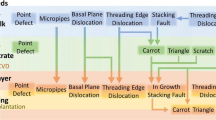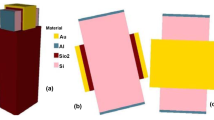Abstract
Single-event charge collection is controlled by drift, diffusion and the bipolar effect. Previous work has established that the bipolar effect is significant in the p-type metal-oxide-semiconductor field-effect transistor (PMOS) in 90 nm technology and above. However, the consequences of the bipolar effect on P-hit single-event transients have still not completely been characterized in 65 nm technology. In this paper, characterization of the consequences of the bipolar effect on P-hit single-event transients is performed by heavy ion experiments in both 65 nm twin-well and triple-well complementary metal-oxide-semiconductor (CMOS) technologies. Two inverter chains with clever layout structures are explored for the characterization. Ge (linear energy transfer (LET) = 37.4 MeV cm2/mg) and Ti (LET = 22.2 MeV cm2/mg) particles are also employed. The experimental results show that with Ge (Ti) exposure, the average pulse reduction is 49 ps (45 ps) in triple-well CMOS technology and 42 ps (32 ps) in twin-well CMOS technology when the bipolar effect is efficiently mitigated. This characterization will provide an important reference for radiation hardening integrated circuit design.
Similar content being viewed by others
References
Black J D, Dodd P E, Warren K M. Physics of multiple-node charge collection and impacts on single-event characterization and soft error rate prediction. IEEE T Nucl Sci, 2013, 60: 1836–1851
Chatterjee I, Narasimham B, Mahatme N N, et al. Impact of technology scaling on SRAM soft error rates. IEEE T Nucl Sci, 2014, 61: 3512
Huang P C, Chen S M, Chen J J, et al. Novel N-hit single event transient mitigation technique via open guard transistor in 65 nm bulk CMOS process. Sci China Tech Sci, 2013, 56: 271–279
Chen J J, Chen S M, Liang B, et al. Single event transient pulse attenuation effect in three-transistor inverter chain. Sci China Tech Sci, 2012, 55: 867–871
Cavrois V F, Massengill L W, Gouker P. Single event transients in digital CMOS—A review. IEEE T Nucl Sci, 2014, 60: 1767
Gadlage M J, Ahlbin J R, Narasimham B, et al. Single-event transient measurements in nMOS and pMOS transistors in a 65-nm bulk CMOS technology at elevated temperatures. IEEE T Device Mater Rel, 2011, 11: 179–186
Amusan O A, Massengill L W, Bhuva B L, et al. Design techniques to reduce SET pulse widths in deep-submicron combinational logic. IEEE T Nucl Sci, 2007, 54: 2060–2064
He Y B, Chen S M. Simulation study of the selectively implanted deep-n-well for PMOS SET mitigation. IEEE T Nucl Sci, 2014, 14: 99–103
Narasimham B, Bhuva B L, Schrimpf R D, et al. Effects of guard bands and well contacts in mitigating long SETs in advanced CMOS processes. IEEE T Nucl Sci, 2008, 55: 1708–1713
Narasimham B, Gambles J W, Shuler R L, et al. Quantifying the effect of guard rings and guard drains in mitigating charge collection and charge spread. IEEE T Nucl Sci, 2008, 55: 3456–3460
Chen J J, Chen S M, Liang B, et al. Simulation study of the layout technique for P-hit single-event transient mitigation via the source isolation. IEEE T Device Mater Rel, 2012, 12: 501–509
Chen S M, Chen J J. Temperature dependence of P-hit single event transient pulse width in three transistors inverter chain. Chin Phys B, 2012, 21: 016104
Chen J J, Chen S M, He Y B, et al. Novel layout technique for single-event transient mitigation using dummy transistor. IEEE T Device Mater Rel, 2013, 13: 177–184
Cavrois V F, Pouget V, Mc Morrow D, et al. Investigation of the propagation induced pulse broadening (PIPB) effect on single event transients in SOI and bulk inverter chains. IEEE T Nucl Sci, 2008, 55: 2842–2853
Narasimham B, Ramachandran V, Bhuva B L, et al. On-chip characterization of single-event transient pulsewidths. IEEE T Device Mater Rel, 2006, 6: 543–549
Ahlbin J R, Massengill L W, Bhuva B L, et al. Single-event transient pulse quenching in advanced CMOS logic circuits. IEEE T Nucl Sci, 2009, 56: 3050–3056
Atkinson N M, Ahlbin J R, Witulski A F, et al. Effect of transistor density and charge sharing on single-event transients in 90-nm bulk CMOS. IEEE T Nucl Sci, 2011, 58: 2578–2584
Author information
Authors and Affiliations
Corresponding author
Rights and permissions
About this article
Cite this article
Chen, J., Liang, B. & Chi, Y. Experimental characterization of the bipolar effect on P-hit single-event transients in 65 nm twin-well and triple-well CMOS technologies. Sci. China Technol. Sci. 59, 488–493 (2016). https://doi.org/10.1007/s11431-015-5999-5
Received:
Accepted:
Published:
Issue Date:
DOI: https://doi.org/10.1007/s11431-015-5999-5




